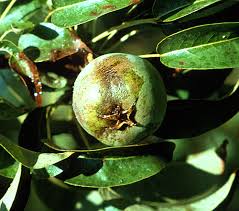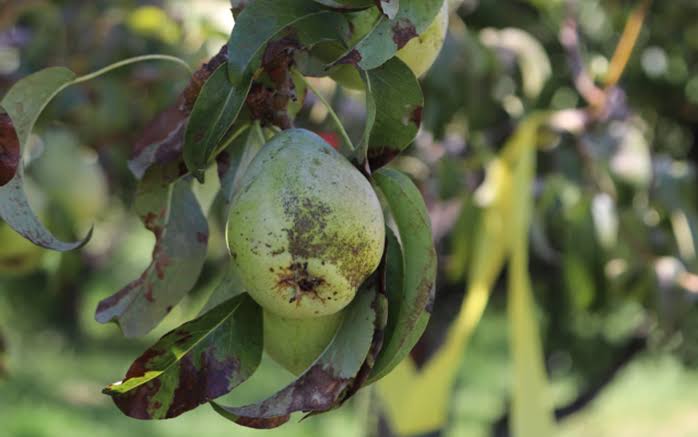Pear Psylla scientifically known as Cacopsylla pyricola is a tiny insect that can cause big trouble for pear trees, this small sap-sucking bug, with its scientific name Cacopsylla pyricola, is known for its impact on pear orchards worldwide.
These pesky insects measure only a few millimeters in size but can wreak havoc on pear trees by feeding on their sap. The scientific name, Cacopsylla pyricola, might sound complex, but it simply refers to this specific species of psyllid that targets pear trees.
Pear psylla infestations can lead to stunted growth, distorted leaves, and even damage to the fruit. Farmers and orchardists often face challenges in managing these insects as they reproduce rapidly, causing widespread issues in pear orchards.
The life cycle of Pear Psylla involves various stages, including egg, nymph, and adult. Understanding these stages is crucial for effective pest management. Eggs are laid on pear tree branches, and when they hatch, the nymphs feed on the sap. As they mature, they go through several instars before becoming winged adults.
Integrated pest management strategies are employed to control Pear Psylla and minimize the damage they cause. This may involve the use of beneficial insects, such as predators or parasites, to keep psylla populations in check. Additionally, applying insecticides and maintaining good orchard hygiene are common practices to manage these pests.
The impact of Pear Psylla on pear trees extends beyond mere aesthetic concerns. Infestations can lead to reduced fruit quality and yield, affecting the livelihoods of those who depend on pear cultivation. Therefore, ongoing research is conducted to develop sustainable and environmentally friendly methods to control Pear Psylla and protect pear orchards.
In addition, Pear Psylla, scientifically known as Cacopsylla pyricola, may be small in size, but its presence can have significant consequences for pear trees and the agricultural communities that rely on them. Effective pest management is essential to mitigate the impact of these tiny insects and ensure the continued success of pear orchards worldwide.
Read Also: How to Grow, Use and Care for Whitetinge Sedge Grass (Carex albicans)
Plants Affected by Pear Psylla (Cacopsylla pyricola)

Pear Psylla (Cacopsylla pyricola) primarily affects pear trees (Pyrus species). These tiny insects specifically target pear orchards, where they feed on the sap of the trees. The infestation can lead to various issues, including stunted growth, distorted leaves, and damage to the fruit of pear trees.
The relationship between Pear Psylla and pear trees is particularly significant, as the insects lay their eggs on pear tree branches. The nymphs then hatch and proceed to feed on the sap, causing harm to the overall health and vitality of the tree. This close association makes pear orchards susceptible to infestations and underscores the importance of effective pest management strategies in pear cultivation.
The impact of Pear Psylla on pear trees goes beyond mere physical damage. As these insects feed on the sap, they extract essential nutrients from the trees, leading to weakened and stressed plants. This weakening of the pear trees can result in reduced fruit quality and yield, affecting the economic viability of pear orchards.
The damage caused by Pear Psylla is not limited to a single season; it can have lasting effects on the health of the pear trees. Young trees, in particular, may suffer more severely, hampering their growth and development. Additionally, the distorted leaves and weakened branches make the trees more susceptible to other environmental stresses and diseases.
Farmers and orchardists face the challenge of managing Pear Psylla infestations to ensure the long-term sustainability of their pear crops. Integrated pest management practices, which involve a combination of biological, cultural, and chemical control methods, are often employed to strike a balance between effective pest control and minimizing environmental impact.
In some cases, beneficial insects like parasitoids or predators are introduced into the orchards to naturally control Pear Psylla populations. This biological control approach aims to harness the natural enemies of the psyllids to keep their numbers in check. Additionally, carefully timed applications of insecticides may be used to target the psylla nymphs and adults, preventing further damage to the pear trees.
The ongoing research and development of new techniques for managing Pear Psylla underscore the importance of sustaining pear orchards. Farmers and scientists collaborate to find innovative and sustainable solutions that minimize the use of chemical interventions while effectively controlling psylla populations.
The relationship between Pear Psylla and pear trees is intricate, with the potential for significant consequences on the health and productivity of pear orchards. Addressing these challenges requires a holistic and integrated approach to pest management, ensuring the resilience of pear trees and the continued success of pear cultivation.
Read Also: How to Grow, Use and Care for Whitegrass (Leersia virginica)
Damages Caused by Pear Psylla

Pear Psylla (Cacopsylla pyricola) infestations can cause various damages to pear trees, affecting both the appearance and productivity of the orchard. The damages caused by these tiny insects include:
1. Stunted Growth: Pear Psylla feeds on the sap of pear trees, extracting vital nutrients. This can lead to stunted growth in both young and mature trees. The overall health and vigor of the trees may be compromised, impacting their ability to develop properly.
2. Distorted Leaves: The feeding activity of Pear Psylla nymphs can result in distorted and curled leaves. This not only affects the aesthetic appeal of the pear trees but also interferes with their ability to carry out photosynthesis effectively.
3. Fruit Damage: Pear Psylla infestations can harm the developing fruit. Feeding on the sap weakens the fruit structure, making them more susceptible to physical damage and deformities. This, in turn, leads to reduced fruit quality and market value.
4. Honeydew Production: Pear Psylla excretes honeydew, a sugary substance, as a byproduct of feeding. The accumulation of honeydew on leaves and fruit can attract other pests, such as ants and sooty mold. This further exacerbates the challenges faced by pear orchards.
5. Weakened Trees: Prolonged infestations by Pear Psylla weaken the overall health of pear trees. Weakened trees become more vulnerable to other stressors, including environmental factors and diseases. This weakened state can have long-term consequences for the sustainability of the orchard.
6. Reduced Yield: One of the most significant economic impacts of Pear Psylla is the reduction in fruit yield. Weakened and damaged trees produce fewer and lower-quality fruits, affecting the income of farmers and the overall productivity of pear orchards.
Addressing the damages caused by Pear Psylla requires proactive pest management strategies. Integrated approaches that consider biological control, cultural practices, and judicious use of insecticides are crucial for minimizing the impact of these pests on pear trees and ensuring the long-term success of pear cultivation.
Control and Preventive Measures
Controlling and preventing Pear Psylla (Cacopsylla pyricola) infestations in pear orchards involves a combination of strategies aimed at reducing psylla populations and minimizing their impact on tree health. Here are some key control and preventive measures:
1. Biological Control:
Introduce natural enemies: Encourage the presence of beneficial insects, such as parasitoids and predators, that feed on Pear Psylla. This biological control helps maintain a balance in psylla populations.
Maintain biodiversity: Promote a diverse environment around the orchard to support natural predators that can contribute to controlling psylla numbers.
2. Cultural Practices:
Pruning: Regular pruning helps improve air circulation and sunlight penetration, creating less favorable conditions for Pear Psylla. Remove and destroy infested plant material during pruning.
Weed management: Keep the orchard free from excessive weeds, as these can serve as alternative hosts for psylla. Controlling weeds reduces potential breeding sites.
3. Chemical Control:
Insecticides: Apply insecticides at appropriate times during the psylla life cycle to target nymphs and adults. Follow recommended guidelines for application to minimize the impact on beneficial insects and the environment.
4. Monitoring:
Regular scouting: Monitor pear orchards for signs of Pear Psylla infestations. Early detection allows for timely intervention and prevents population build-up.
Degree-day models: Use temperature-based models to predict psylla development stages, helping to time control measures more effectively.
5. Resistant Varieties:
Plant resistant cultivars: Consider planting pear tree varieties that have demonstrated resistance or tolerance to Pear Psylla. This can be an effective long-term strategy to reduce reliance on chemical control.
6. Horticultural Oils:
Apply horticultural oils: Use horticultural oils during the dormant season to smother overwintering Pear Psylla eggs. This can be part of an integrated pest management approach.
7. Trap Crops:
Implement trap crops: Grow specific plants that attract Pear Psylla away from the main pear orchard. This diversionary tactic can help reduce psylla pressure on pear trees.
8. Sanitation:
Remove infested plant material: Eliminate and destroy plant material hosting Pear Psylla eggs or nymphs to disrupt their life cycle and prevent further infestations.
Implementing a combination of these control and preventive measures, tailored to the specific conditions of the orchard, is crucial for managing Pear Psylla effectively and maintaining the health and productivity of pear trees. Integrated pest management approaches that minimize environmental impact and promote sustainability are increasingly important in modern agriculture.
Frequently Asked Questions (FAQs) About Pear Psylla (Cacopsylla pyricola)
Q1: What is Pear Psylla?
A1: Pear Psylla (Cacopsylla pyricola) is a small insect that feeds on the sap of pear trees. It can cause damage to pear orchards by affecting tree growth, leaves, and fruit.
Q2: How small are Pear Psylla insects?
A2: Pear Psylla measures only a few millimeters in size, making them challenging to detect without close inspection.
Q3: What kind of damage can Pear Psylla cause to pear trees?
A3: Pear Psylla can cause stunted growth, distorted leaves, fruit damage, and overall weakening of pear trees. Infestations can lead to reduced fruit quality and yield.
Q4: How can I identify Pear Psylla infestations in my pear orchard?
A4: Look for distorted leaves, curled foliage, and signs of honeydew on leaves and fruit. Regular monitoring and scouting are essential for early detection.
Q5: Are there natural enemies of Pear Psylla?
A5: Yes, beneficial insects such as parasitoids and predators can help control Pear Psylla populations. Encouraging biodiversity in the orchard supports these natural enemies.
Q6: What are integrated pest management (IPM) strategies for Pear Psylla?
A6: IPM strategies include biological control, cultural practices like pruning and weed management, judicious use of insecticides, monitoring, and planting resistant varieties.
Q7: Can Pear Psylla infestations be prevented?
A7: While complete prevention may be challenging, implementing preventive measures such as regular monitoring, horticultural oils, and sanitation practices can reduce the risk of infestations.
Q8: When is the best time to apply insecticides for Pear Psylla control?
A8: Timing is crucial. Insecticides should be applied during specific stages of the psylla life cycle, targeting nymphs and adults. Consult local guidelines for optimal timing.
Q9: Are there pear tree varieties resistant to Pear Psylla?
A9: Some pear tree varieties exhibit resistance or tolerance to Pear Psylla. Planting these varieties can be part of a proactive strategy to minimize infestation risk.
Q10: How can I minimize the environmental impact of controlling Pear Psylla?
A10: Adopt integrated pest management practices, use environmentally friendly insecticides, and promote sustainable approaches such as biological control to minimize environmental impact.
Read Also: Your Role as a Consumer, Wage Earner, Citizen, and Who Benefits from a Business?
